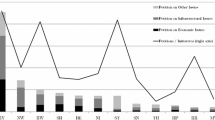Abstract
The ``Law of 1/n'' postulates a positive relationship betweenthe number of democratically electedrepresentative districts and governmentspending. Strong support for thisrelationship exists in legislatures in theUnited States (at both the state andnational level) and across countries. Fewstudies have examined this relationship atthe local level despite the fact that localgovernments operate under constraintssimilar to those faced by representativelegislatures. Using a sample of Georgiacounties we find the number of countycommissioners to be positively correlatedwith county government expenditures,indicating support for the Law of 1/nat the local level.
Similar content being viewed by others
References
Bailey, S.J. and Connolly, S. (1998). The flypaper effect: Identifying areas for further research.Public Choice 95: 335-361.
Bradbury, J.C. (2000). The political economy of legislative organization: An empirical analysis. Unpublished doctoral dissertation. George Mason University, Fairfax, VA.
Bradbury, J.C. and Crain, W.M. (2001). Legislative organization and government spending: Cross-country evidence. Journal of Public Economics 82: 309-325.
Caplan, B.D. (2001). Standing Tiebout on his head: Tax capitalization and the monopoly power of local governments. Public Choice 108: 101-122.
Crain, W.M. and Tollison, R.D. (1991). Predicting politics: Essays in empirical public choice.Ann Arbor: University of Michigan Press.
Dalenberg, D.R. and Duffy-Deno, K. (1991). At-large versus ward elections: Implications for public infrastructure. Public Choice 70: 355-342.
DelRossi, A.F. and Inman, R.P. (1999). Changing the price of pork: The impact of local cost sharing on legislator's demands for distributive public goods. Journal of Public Economics 71: 247-273.
Deno, K. and Mehay, S.L. (1987). Municipal management structure and fiscal performance: Do city managers make a difference? Southern Economic Journal 53: 627-642.
Farnham, P.G. (1990). The impact of citizen influence on local government expenditure.Public Choice 64: 201-212.
Gilligan, T.W. and Matsusaka, J.G. (1995). Deviations from constituent interests: The role of legislative structure and political parties in the states. Economic Inquiry 33: 383-401.
Gilligan, T.W. and Matsusaka, J.G. (2001). Fiscal policy, legislature size, and political parties: Evidence from state and local governments in the first half of the 20th century. National Tax Journal 54: 57-82.
Inman, R.P. (1978). Testing political economy's ‘as if’ proposition: Is the median voter really decisive? Public Choice 33: 45-65.
Inman, R.P. and Fitts, M.A. (1990). Political institutions and fiscal policy: Evidence from the US historical record. Journal of Law, Economics, and Organization 6: 79-132.
Kontopoulos, Y. and Perotti, R. (1999). Government fragmentation and fiscal policy outcomes: Evidence from OECD countries. In: J. Poterba and J. von Hagen (Eds.), Fiscal institutions and fiscal performance, 81-102. Chicago: University of Chicago Press.
Langbein, L.L., Crewson, P. and Brasher, C.N. (1996). Rethinking ward and at-large elections in cities: Total spending, the number of locations of selected city services, and policy types. Public Choice 88: 275-293.
Morgan, D.R. and Pelissero, J.P. (1980). Urban policy: Does political structure matter? American Political Science Review 74: 999-1006.
Moser, P. (1999). The impact of legislative institutions on public policy: A survey. European Journal of Political Economy 15: 1-33.
Reid, G.J. (1991). Tests of institutional versus non-institutional models of local public expenditure determination. Public Choice 70: 315-333.
Sass, T.R. (1991). The choice of municipal government structure and public expenditures.Public Choice 71: 71-87.
Southwick, L. (1997). Local government spending and at-large versus district representation: Do wards result in more ‘pork’? Economics and Politics 9: 173-203.
Stein, E., Talvi, E. and Grisanti, A. (1999). Institutional arrangements and fiscal performance: The Latin America experience. In: J. Poterba and J. von Hagen (Eds.), Fiscal institutions and fiscal performance, 103-133. Chicago: University of Chicago Press.
Tullock, G. (1959). Some problems of majority voting. Journal of Political Economy 67: 571-579.
Turnbull, G.K. and Djoundourian, S.S. (1993). Overlapping jurisdictions: Substitutes or complements? Public Choice 75: 231-245.
Weingast, B., Shepsle, K. and Johnsen, C. (1981). The political economy of benefits and costs: A neoclassical approach to distributive politics. Journal of Political Economy 89: 642-664.
Author information
Authors and Affiliations
Rights and permissions
About this article
Cite this article
Bradbury, J.C., Stephenson, E.F. Local Government Structure and Public Expenditures. Public Choice 115, 185–198 (2003). https://doi.org/10.1023/A:1022857028836
Issue Date:
DOI: https://doi.org/10.1023/A:1022857028836




